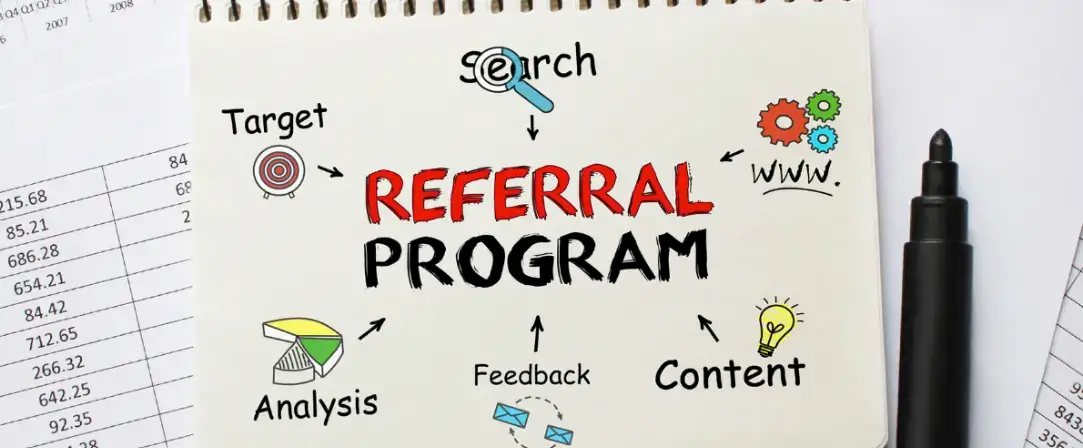The efficiency of consumer referral programs appears to have little to do with rationale yet everything to do with the most fundamental aspects of human nature. How would that be? Find out by reading on!
Have you ever paid for a subscription to a video streaming service or online magazine you did not need? Have you ever purchased something only because a buddy told you to? If the answer to both questions is yes, you have been swayed.
In this article:
- How Do Client Referrals Work?
- How Effective are Referral-Giving Programs?
- The Psychology Principles of Referral Programs
- How Can Customer Referral Programs Be More Powerful?

Custom image created in Canva
But remember that everyone has been misled at some time, so do not allow these details to make you feel horrible about yourself.
The matter at hand is this: According to sources of authority, people are naturally motivated to say “yes” by a fundamental aspect of human nature. Simply put, our brains are hard-wired to engage in the action.
And for precisely this reason, client referral tactics are so successful in 2023. Referred clients are more inclined to purchase from you (in any referral concept).
Furthermore, no matter if those peers are employees, up to 92% of customers place the highest level of faith in endorsements from relatives and close friends over all other promotion types.
Customer referral programs are founded on fundamental human psychology, which is still present today. Customer recommendations will still be helpful in 100 years.
If you are aiming to learn:
- Why referrals are effective,
- the mentality behind referral schemes, and
- how to improve referral programs by utilizing these psychological concepts,
You will appreciate the in-depth details in this article. Let us begin straight away!
How Do Client Referrals Work?
Referrals operate by enlisting a legion of happy clients to recommend your company to those close to them.
But here is the truth: Counting on a group of contented clients to expand your clientele without providing anything in exchange is nothing more than wishful thinking.
In actuality, referral strategies that offer something in return are the most effective.
We will demonstrate this on Dropbox, which can serve us as a case study.
- Individuals who accepted a request and referred a friend received more cloud storage space from the cloud file hosting service.
- A two-sided referral tactic has enabled Dropbox to expand from 100K registered users in 2008 to over 600M registered users and 14.3 million paying subscribers in 2019.
That is just remarkable, isn’t it?
How Effective Are Referral-Giving Programs?
Programs for customer referrals are a powerful marketing strategy that may help any company.
83% of online those surveyed in a 2015 study said they trusted recommendations from friends and family.
The conversion rate from client referrals is three times higher than the sector average of 3.64%.
While the total lifetime revenue generated by referred clients is 16% greater than the value of non-referred customers, referred consumers have 4.5 cents daily greater earnings than other consumers.
The Psychology Principles of Referral Programs

Custom image created in Canva
Although marketing may appear complicated, it requires identifying and activating the psychological triggers that will cause a person to purchase your goods.
Dr. Robert Cialdini is the expert on this. An American psychologist offers six general principles of persuasion in his book Influence: The Psychology of Persuasion, including:
Let's further explore each of these six persuasion concepts.
-
Social Proof
Sometimes, people can be strange and eccentric. A typical example is the desire to follow other people’s tastes or behaviors.
Everyone is seeking social approval, whether it is through green diets, Apple Watches, soy lattes, or Slack.
One of the reasons referral systems are so successful is that people want to blend in with the remaining members of the masses.
Let us use an example to help you better comprehend this topic: You have just arrived at the little town of Vila Baleira in Portugal.
You just completed more than 10,000 steps and hundreds of beautiful seaside photos.
When you are hungry, you are looking for a hip restaurant. Which restaurant do you choose—packed to the gills with patrons or without a living soul? Let us venture a guess: the former.
The same holds true when considering whether to buy a good or service. In other words, we do not want the company offering the product or service to provide proof; we want it from our friends, family, or neutral third parties.
We are more likely to buy a product if a friend or family member recommends it to us than, for instance, if we come across the company’s name in an advertisement.
-
Authority
If you google “the authority principle,” you are going to find the following sentence as one of the results (we paraphrase):
The authority principle describes a person's propensity to submit to those in places of authority, such as legislators, law enforcement officers, physicians, attorneys, academics, and other professionals regarded as authorities in various disciplines.
But how can a referral program implement this idea?
The authority concept does not apply to police officials or attorneys in marketing, though. Instead, it describes those who are more informed than we are about a subject; as a result, we are more willing to heed their advice.
Imagine, for instance, that one of your friends is a highly competent interior designer. You need recommendations for living room furniture suppliers because you are remodeling your house.
Please ask someone who has never refurbished a living room before to contact these suppliers for assistance. Of course, the latter applies.
Customers will trust your service or good if they recommend it to their friends and family, mainly if that person is knowledgeable about the subject.
This person’s recommendation is just as valuable as a famous person’s endorsement.
-
Reciprocity
Another word used in social psychology is reciprocity. In other terms, regardless of whether they have not asked for or need something, people are hard-wired to respond favorably to gifts.
They even experience an immediate sense of debt to the benefactor. The success of referral strategies is precisely due to this fundamental survival technique.
Giving your consumers something, whether extra space for storage or a $50 gift card, creates a social duty for them to repay the favor.
How will they go about doing that? By conveying the good news.
-
Scarcity
Quite a simple customer psychology principle is what scarcity is: When opportunities are scarce, people see them as having more value.
As a result, FOMO (Fear of Missing Out) is triggered, encouraging people to act out of fear of dropping an opportunity.

Custom image created in Canva
Customers purchase the merchandise due to feeling as though time is beginning to run out.
Offline and internet businesses frequently employ the strategy since it is low-risk and simple to administer.
-
Commitment
According to the commitment principle, once an individual has decided or taken a stance, they will experience pressure to act by that commitment.
Take your commitment to running your first marathon, which is scheduled for three months from now, as an example.
Your pals were ecstatic for you when you told them the news. This public declaration encourages you to stick to your objectives and exercise more frequently.
This strategy also excels in the field of marketing. In reality, companies frequently use the commitment and consistency principles to boost customer loyalty and revenue.
One idea for keeping up with campaign news is pledging to leave a phone or email address.
You will eventually begin to get more and more inquiries from the brand. You were only a casual website user when you first visited, but now you are an active community participant.
-
Liking
According to “the liking principle,” we are more inclined to follow advice from individuals we like and aspire to be like.
It is difficult for us to refuse someone the more we appreciate them. It is the primary justification given by businesses for using celebrity endorsements to market their goods or turn their most devoted consumers into brand ambassadors.
Three primary liking characteristics that affect customer behavior are:
- Physical appeal: Physical appeal indicates sincerity.
- Similarity: We enjoy spending time with others who share our interests, backgrounds, and other characteristics.
- Praises: We enjoy receiving accolades and find those who do so attractive.
Let us look at how you can use your information about the six fundamental principles of social psychology to improve your referral programs.
How Can Customer Referral Programs Be More Powerful?

Custom image created in Canva
-
Rewards before requesting a referral
Give the consumer something first, ahead of you asking for a referral.
The probability that a consumer will recommend your product or service to their friends improves if you provide something beforehand, asking for something.
For instance, give them a prize if they successfully finish their customer account or give them a 10% discount when they arrive on your website.
Give birthday gifts and VIP benefits to motivate your customers to continue spreading the news in the future.
-
Provide dual-purpose referral program incentives
As previously discussed, a two-sided referral approach varies from a one-sided one. In a two-sided scheme, the individual getting the referral and the person who made it receive rewards. But why is this strategy so effective?
In addition to receiving a bonus, the referral also gets to offer something to their buddy.
Additionally, since both sides stand to gain, they are more inclined to purchase your goods.
Therefore, if your one-sided referral campaign was giving out $50, consider providing $25 to the individual receiving it and $25 to the individual who introduced them.
-
Highlight customer success stories
Here is a fantastic strategy to improve your referral program: showcase the achievements of your current clients.
Consider describing how a few of your users used the prize or earned money online, for instance.
People are more inclined to promote your product or service to others when they see concrete evidence of the customer referral program’s success stories.
You are making a unique website through one of the ten best website builders with a simple dashboard for running a tiny blog or e-commerce business where you may display favorable client comments about your referral program.
You may even use language like this to highlight how well-liked your application is:
“Our referral program is continually expanding! Join the 1,000 other customers who have already recommended our product to friends to receive rewards!”
-
Leverage influencer marketing
Get this: Brands who invest $1 in influencer marketing see a return of $5.78 on average, with the top 13% of brands earning up to $20 for every $1 spent.
Yes, influencer marketing has become quite popular nowadays and is directly related to the like concept.
Although more expensive, this strategy can expand your audience, raise brand recognition, and quickly attract new clients.

Custom image created in Canva
Simply collaborate with a podcaster, blogger, or social media influencer with a sizable following.
The quantity of followers is essential, but there are other considerations. Ensure that the influencer’s audience is similar to your target market.
We assume you will not allow a beauty blogger to promote your tech product. So be picky.
-
Take advantage of FOMO
Now that you know the influence of FOMO, why not take advantage of it to improve the performance of your referral program?
It is cheap, easy, and straightforward; it makes sense.
Create a special client referral incentive, but include expiration restrictions. Customers will have all weekend to earn it, from Friday until Sunday night.
One option involves presenting client gift ideas exclusively accessible through participation in your referral program.
It can be a one-of-a-kind present or a limited-edition product.
-
Boost social capital
Let’s simplify it. Making people aware of how your program improves their social capital is called social capital in marketing.
In other words, the goal of your referral program should be to enhance the user’s reputation among their peers.
If recommending your product or service would weaken the user’s ties with others, they would refrain from doing so.
Consider the scenario when you suggested a video streaming service to a close friend. The portal, however, continues crashing, and your buddy has been unable to contact customer care.
Eventually, they do not issue a refund when they speak with a support representative.
Your buddy now sees you as someone who recommends awful things and lies to their buddies. You need more social capital.
What your business can do is effectively market your product or service.
Focus on producing fantastic content like blogs and how-to guides, provide high-quality goods, and make sure your customer service, webpage user experience, and refund protocols are all functioning correctly.
It Is Your Turn Now
On the surface, humans may appear sophisticated creatures with complex thinking, peculiar habits, and elaborate emotions.
Although we live in a time of space travel and virtual realities, our mentality is still that of Stone Age hunter-gatherers.
You can only design successful consumer referral programs and accelerate your digital marketing strategies by comprehending this thinking.
By providing new clients a welcome incentive, you may effectively use reciprocity in your program for referrals after you understand how it works.
You might also utilize influencer marketing to your benefit because people are more inclined to trust those they like which will directly impact your marketing conversion rate.
So, with that said, it is your time now! Which impact concept will you include in your program first?

